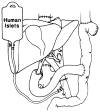Pancreatic islet transplantation after upper abdominal exenteration and liver replacement
- PMID: 1974944
- PMCID: PMC2972674
- DOI: 10.1016/0140-6736(90)91946-8
Pancreatic islet transplantation after upper abdominal exenteration and liver replacement
Abstract
Nine patients who became diabetic after upper-abdominal exenteration and liver transplantation were given pancreatic islet-cell grafts obtained from the liver donor (eight cases), a third-party donor (one), or both (four). Two patients were diabetic when they died of infections after 48 and 109 days, as was a third patient who died of tumour recurrence after 178 days. The other 6 are alive 101-186 days postoperatively, and five are insulin-free or on insulin only during night-time parenteral alimentation. C-peptide increased 1.7 to 3.3 fold in response to intravenous glucose in these five patients who have had glycosylated haemoglobin in the high normal range. However, the kinetics of the C-peptide responses to intravenous glucose in all eight patients tested revealed an absent first-phase release and a delayed peak response consistent with transplantation and/or engraftment of a suboptimal islet cell mass. The longest survivor, who requires neither parenteral alimentation nor insulin, is the first unequivocal example of successful clinical islet-cell transplantation.
Figures
Comment in
-
Pancreatic islet transplantation.Lancet. 1990 Nov 24;336(8726):1323. doi: 10.1016/0140-6736(90)93009-e. Lancet. 1990. PMID: 1978147 No abstract available.
References
-
- Gray DWR, Morris PJ. Developments in isolated pancreatic islet transplantation. Transplantation. 1987;43:321–31. - PubMed
-
- Alejandro R, Mintz DH, Noel J, Latif Z, Koh N, Russel E, Miller J. Islet cell transplantation in type I diabetes mellitus. Transplant Proc. 1987;19:2359–61. - PubMed
-
- Sharp DW, Lacy PE, Ricordi C, et al. Human islet transplantation in patients with type I diabetes. Transplant Proc. 1989;21:2744–45. - PubMed
-
- Warnock GL, Kneteman NM, Ryan EA, Halloran PF, Rabinovitch A, Rajotte RV, et al. Continued function of pancreatic islets after transplantation in type I diabetes. Lancet. 1989;ii:570–72. - PubMed
-
- Scharp DW, Lacy PE, Santiago JV, et al. Insulin independence after islet transplantation into type I diabetic patient. Diabetes. 1990;39:515–18. - PubMed
Publication types
MeSH terms
Grants and funding
LinkOut - more resources
Full Text Sources
Other Literature Sources
Medical



